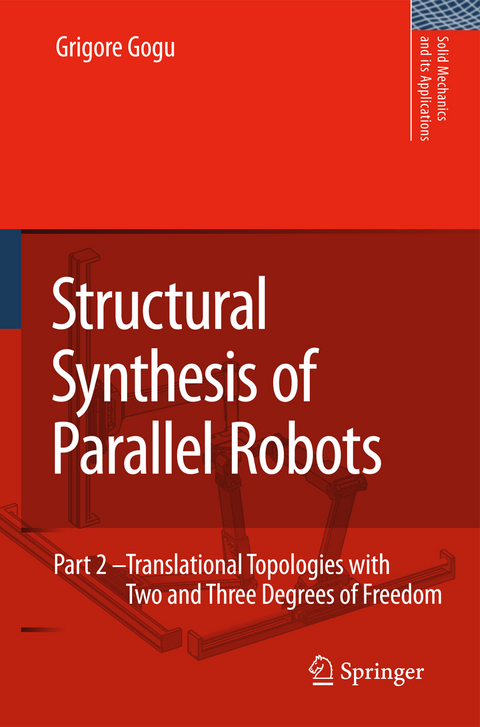
Structural Synthesis of Parallel Robots
Springer (Verlag)
978-90-481-8202-2 (ISBN)
Preface; Acknowledgements; List of abbreviations and notations; 1 Introduction; 1.1 Terminology; 1.2 Methodology of structural synthesis; 1.2.1 New formulae for mobility, connectivity, redundancy and overconstraint of parallel robots; 1.2.2 Evolutionary morphology approach; 1.2.3 Types of parallel robots with respect to motion coupling; 1.3 Translational parallel robots; 2 Translational parallel robots with two degrees of freedom; 2.1 T2-type translational parallel robots with coupled motions; 2.1.1 Overconstrained solutions; 2.1.2 Non overconstrained solutions; 2.2 T2-type translational parallel robots with decoupled motions; 2.2.1 Overconstrained solutions; 2.2.2 Non overconstrained solutions; 2.3 T2-type translational parallel robots with uncoupled motions; 2.3.1 Overconstrained solutions; 2.3.2 Non overconstrained solutions; 2.4 Maximally regular T2-type translational parallel robots; 2.4.1 Overconstrained solutions; 2.4.2 Non overconstrained solutions; 2.5 Other T2-type translational parallel robots; 2.5.1 Overconstrained solution; 2.5.2 Non overconstrained solutions; 3 Overconstrained T3-type TPMs with coupled motions; 3.1 Basic solutions with linear actuators; 3.2 Derived solutions with linear actuators; 3.3 Basic solutions with rotating actuators; 3.4 Derived solutions with rotating actuators; 4 Non overconstrained T3-type TPMs with coupled motions; 4.1 Basic solutions with linear actuators; 4.2 Derived solutions with linear actuators; 4.3 Basic solutions with rotating actuators; 4.4 Derived solutions with rotating actuators; 5 Overconstrained T3-type TPMs with uncoupled motions; 5.1 Basic solutions with rotating actuators; 5.2 Derived solutions with rotating actuators; 6 Non overconstrained T3-type TPMs with uncoupled motions; 6.1 Basic solutions with rotating actuators; 6.2 Derived solutions with rotating actuators; 7 Maximally regular T3-type translational parallel robots; 7.1 Overconstrained solutions; 7.1.1 Basic solutions with no idle mobilities; 7.1.2 Derived solutions with idle mobilities; 7.2 Non overconstrained solutions; References; Index
| Reihe/Serie | Solid Mechanics and Its Applications ; 159 |
|---|---|
| Zusatzinfo | XVIII, 762 p. |
| Verlagsort | Dordrecht |
| Sprache | englisch |
| Maße | 155 x 235 mm |
| Themenwelt | Mathematik / Informatik ► Mathematik ► Wahrscheinlichkeit / Kombinatorik |
| Naturwissenschaften ► Physik / Astronomie ► Mechanik | |
| Technik ► Elektrotechnik / Energietechnik | |
| Technik ► Maschinenbau | |
| ISBN-10 | 90-481-8202-6 / 9048182026 |
| ISBN-13 | 978-90-481-8202-2 / 9789048182022 |
| Zustand | Neuware |
| Informationen gemäß Produktsicherheitsverordnung (GPSR) | |
| Haben Sie eine Frage zum Produkt? |
aus dem Bereich


